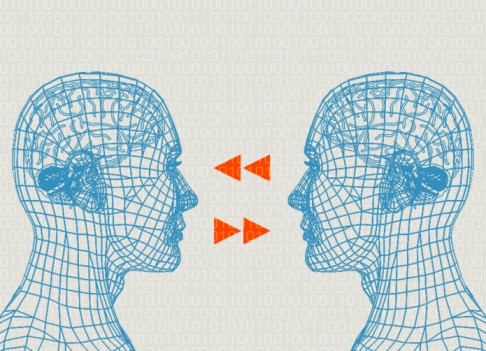Many people believe natural language is the new operating system of our lives. This isn’t new news — one doesn’t need to look any further than the resurgence of podcasts or everyone’s new best friends Alexa, Siri, Bixby and Cortana to see voice is the next frontier for brands. We’ve gone from people trying to talk like computers to computers being able to imitate us.
GE has been experimenting in the space for a while, from our podcasts The Message and Life After to using Alexa to guide you through a Labracadabra science experiment to GE Lighting’s Alexa-integrated table lamp. Recently, we announced that the 600,000+ digital twins we’ve made to model the exact condition of our customer’s assets will be voiced by none other than Microsoft’s Cortana.

But I don’t know that any of us understood how dramatically this interface would permeate our lives. These voices are in our homes. They have a seat at our dinner table. They watch TV with us. They greet us in the morning, and sing us to sleep at night. In some ways, they know us better than anyone else. Think I’m being dramatic? Amazon researchers are reportedly exploring ways to track emotion in a person’s voice and better understand their intent. Brands will have the opportunity to pinpoint what desire sounds like prior to purchase, and to understand not only the demographics of their audience, but also their disposition.
This means consumers will demand more from brands than a beautiful app or a viral video. They want to have a conversation. A real, audible, human conversation. If voice is now the operating system of our lives, then conversation becomes table stakes for brands.
Think long and hard about how you want that conversation to go. Can you clearly articulate your brand’s core offering in a way that displays meaningful value? Do you have a vision for the type of relationship you want to have with your customers? These questions matter, because at the core of every operating system are the values of its builders.
Case in point: the recent Google Home ad depicting a young, wand-wielding boy standing in front of his dog. When Abracadbra or Alakazam don’t do the trick, his mother, also donning her cape, asks their Google Home what the magic word is. “Please” resounds back in response. The boy tries again, and sure enough, he whispers “It worked!”
Google Home TV Commercial, ‘The Magic Word: YouTube Trial’
A young wizard tries out a number of spells (hocus-pocus, abra-cadabra, alakazam) on a quizzical looking pup, but the…ispot.tv
Having raised two children of my own (without Alexa around), it shouldn’t come as a surprise to me that when an AI-enabled blinking white orb gives advice about manners, it can stick better than mom or dad repeating clichés. Still, these home assistants open the door to third-party parenting. Whether through etiquette lessons or homework help, Alexa may become the au pair à la mode.
What will the impact be on these children, who will have spent their lives learning from and leaning on their AI assistants, as they grow up? We see the potential impacts already in the discussion around the gendering of AI. Female voices are most popular and widely used. Of the big players in the space (Apple, Microsoft, Google, and Amazon), Siri is the only one whose gender can be switched to male.
Researchers have also found that users prefer a male voice when learning (like how to use a computer) and prefer a female voice when getting life advice. In 2010, Adweek and Harris Interactive surveyed Americans and uncovered that male voices are described as forceful while women were more soothing. New York subway-riders need not look further than the voices behind MTA announcements. Charlie Pellett (known for his greatest work “Stand clear of the closing doors”) was chosen for his “friendly, yet authoritative” voice. His female counter-part Carolyn Hopkins (of “Never leave your bags unattended” fame), had the “very happy smiling voice” that ended up proliferating across 200+ airports, major subway systems and even dishwasher systems. The difference in tone & the effect it has on listeners is pervasive.
Honestly, I don’t like the idea of women being the default assistants in our lives. AI may replace some human interaction, but our assistants will still impact us the way human interaction does. They will respond to our frustration, feed our delight, make our lives run smoothly. How they do that depends on how we create them. On the social norms, worldviews and moral codes we give them. The foundational values upon which we build the operating system of voice matter.
Many studies show the more cognitively diverse a team is, the faster and more powerful outputs will be. At GE, we agree, which is why we launched #BalancetheEquation, an initiative which aims to have 20,000 women in technical roles by 2020. If you hire only young white male coders, you’re going to get only the outputs of a young white male. The result? A narrow worldview that is perpetuated throughout homes and workplaces, limiting the potential for innovation.

The personalities and psychologies we instill in these assistants will reveal more about our own personalities and psychologies than anything else. The same is true for brands. As Silicon Valley builds values into the operating system of voice, we marketers need to plan for the operating system of our brands, based on core values. What is your brand’s operating system? What is a conversation with your brand like? Does it sound like an infomercial, or is it imbued with understanding and conviction? Do you super-serve a utility, or prompt conversation and drive social connection? With voice as the new interface of choice, these questions aren’t hypothetical, so our answers shouldn’t be either.
Let me know your thoughts.
Originally published at medium.com


